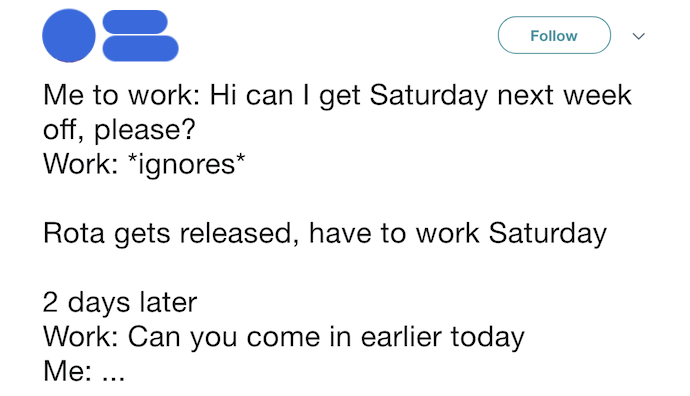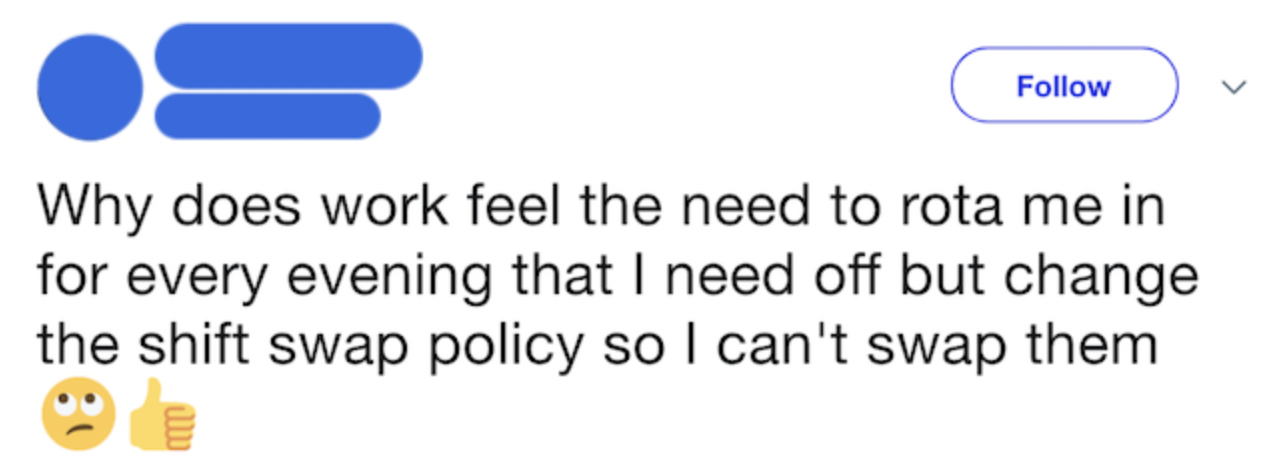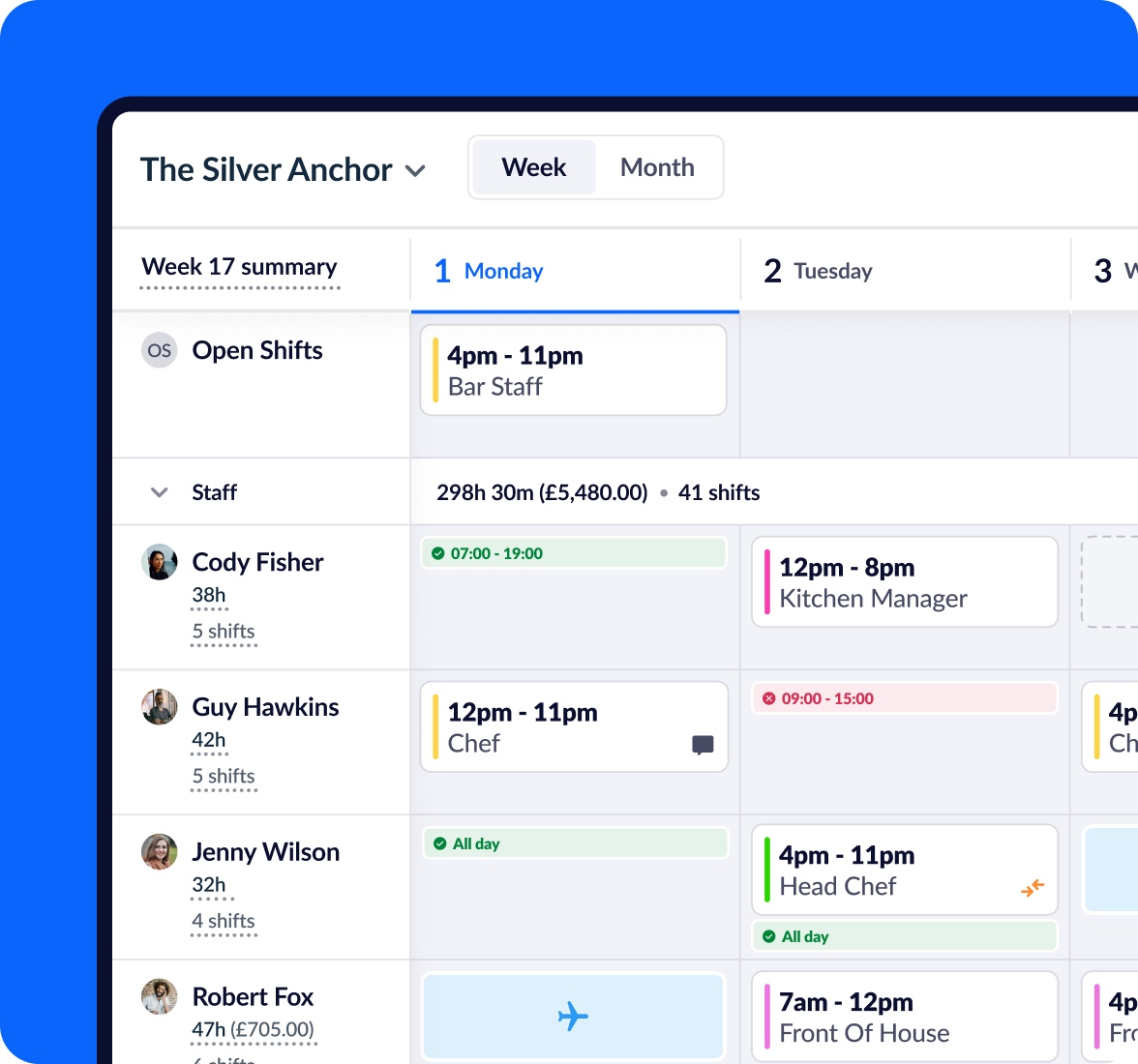Putting together a work rota is hard enough without having to accommodate individual preferences for particular shifts or days off.
Duty rotas are necessary for many businesses to function, but many employees will likely have days or times that they can't or would prefer not to work. Perhaps they have exams to study for, have kids to pick up, or find it difficult to travel at certain times.
When your staff have agreed to work to a flexible rota, it can be tempting to take a "like it or lump it" approach to shift planning. But ignoring their requests can impact both their morale and performance, as well as the future success of your business.
Let's take a look at some real-life examples of when bosses failed to accommodate their employees' shift preferences and the effect it had. Then we'll explore the ways managers can strike a balance between keeping their staff happy and successfully running their business.
The complaint
A quick trawl of social media shows just how often people are frustrated by their managers denying or ignoring their requests.
Here's a small sample of the work rota complaints shared with the world via Twitter.
Was this employee's request ignored or just forgotten?

Staff are unlikely to help you out if you don't help them in return.

Sounds like someone's moving the goalposts...

Another frustrated employee.

And then there are mistakes like this.

It's pretty clear from these examples that ignoring requests or having no system in place to accommodate their needs is incredibly frustrating and demotivating.
The fallout
So, what are the consequences of allowing this at your business?
The following are commonly seen at companies where employees' shift requests are forgotten, ignored, or flat-out denied:
- Frustrated staff. As the above tweets show, when managers repeatedly forget that their staff aren't free to work on certain days, or ignore their requests entirely, it can be incredibly frustrating. This, in turn, can lead to...
- Low morale. It's hard to feel valued when your boss schedules you in for shifts that you've already told them are difficult for you — especially if the first you hear about it is when your name appears on the work rota.
You can't expect your staff to show up for work with a positive attitude if their shifts negatively impact their personal lives. - Constant work rota changes. Give your employees shifts that they can't work, and, more often than not, you'll end up having to find cover for them and then update the rota. This can cause rota mix-ups between staff, missed shifts, and even legal problems if those providing cover end up working more than their contracted hours.
- High turnover. Ultimately, if your staff become so frustrated, they'll jump ship the minute something better comes along. That means more costly recruitment, interviewing, and training for you.

See your staff's availability — right there on the rota
RotaCloud lets your staff communicate when they are (and aren't) free to work via our free mobile app, making it easier for you to plan rotas that work for everyone.
The solution
It's impossible to please everyone 100% of the time, but routinely ignoring staff's requests for shifts or days off can be damaging for your business.
Here's what you can do to more easily accommodate employees' preferences for shifts, without it eating into your time (or negatively impacting your work rota).
Make availability part of your recruitment process
Ask candidates during the interview process whether they have any particular days or shifts that they can't work, and keep a log of them — especially when hiring for part-time positions.
As well as helping you decide whether you're a good fit for each other, this will give you something to base your work rotas on should you decide they're right for your team.
Stick to a pattern
Rather than mixing shifts up or starting from scratch every week, try to establish a pattern for your work rota and stick to it. Create a weekly, fortnightly, or monthly template, and use this as the basis for all future rotas.
This way, your staff will be better able to plan their personal lives, and you'll have fewer last-minute requests for changes every time you publish a new work rota.
Set up a process for making shift requests
Many staff shift requests go unfulfilled because they get forgotten about.
Rather than relying on memory or scraps of paper, set up a formal process for your staff to follow when requesting shifts, whether it's by sending an email, filling out a form, or through software like RotaCloud. Choose whatever's best for your team and for you, but definitely ensure there's a record and a clear process to follow.
Set a deadline for making shift & availability requests
Be sure to set a deadline for requests (ideally 3-5 days before publishing or sharing your next work rota) to allow yourself enough time to plan shifts accordingly.
Make your staff a deal: you'll do your best to meet their needs, as long as they give you plenty of notice. A win-win for you both!
Let staff swap shifts
If you decide that you'd rather let your staff trade shifts they're unable to work than create the rota around their preferences, it's important to formalise the process so that nothing is left to chance.
If your staff can swap shifts or have colleagues provide cover, you need to ensure that this is documented and, ideally, signed off by a senior member of staff before the rota's updated.
Again, you'll need to set some kind of deadline for shift swaps — for example, they must be received no less than 48 hours before the shift in question starts.
(Read about the benefits of shift swapping and best practices here!)
Use a cloud-based rota system
Online systems like RotaCloud allow staff to...
...All through an app — which is free to install on their phones.
Managers have this information available when planning the rota, and the system alerts them if they're about to schedule a shift for someone who's not available. No more mistakes or forgotten holiday requests!
Staff can also use the app to organise shift swaps between them, saving their managers hassle and admin time. The rota manager receives a notification for a swap (or drop or leave) request, which they approve or reject, and the work rota updates automatically.
Final thoughts
Like all aspects of staff management, rota planning is about give and take.
You expect your staff to show up on time, ready to go, but you'll only get the best out of them if you keep their preferences in mind when assigning shifts.
True, this may take up a little more of your time than simply slotting staff members into shifts ad hoc. But you'll probably save yourself countless hours of tweaking and updating once the rota's actually published. Plus, you'll have a team of people who feel valued and respected enough to want to stick around.
Try RotaCloud free for 30 days
Build and share rotas anytime, anywhere — all in less time than it takes to make a coffee.
Read next ➤

"It gives people in the team the power to plan the rota with the person in charge. It's not just one person's responsibility; it gives shared responsibility because it's more fluid with people adding their availability. It allows them to take charge of their own time."
Hear how Cresci Pizzeria improved its rotas and efficiency by allowing more staff input.
Editor's Note: This post was originally published in March 2023 and updated for accuracy in December 2025.



